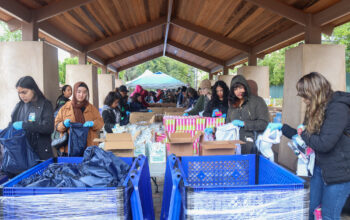Those discreet fake rocks around campus housing poison for rats and mice may have had some unwanted effects.
Faculty have expressed concern that the rabbits and squirrels have become victims of the rodenticide.
“I used to see them all the time. They would have babies so there’d be all sizes running around. It was very active around here,” instructor of English Craig Kramer said. “And just last month we started noticing that there were none. Not a single animal. I can’t remember the last time that I saw one single squirrel or rabbit on campus.”
While Kramer has not seen any dead animals on campus, Shannon DeVaney, instructor of life sciences, has seen dead rabbits.
“If it’s not next to a street, it’s probably been poisoned or something because there’s not a lot of other things that would kill something like a rabbit and not eat it,” DeVaney said.
According to the National Pesticide Information Center website, bromadiolone, the poison used in the traps, prevents the body from recycling Vitamin K, causing the animal to bleed to death, which can take several days.
“It makes them suffer, like a form of torture, and then they die,” Kramer said.
According to DeVaney, the impact goes beyond the ground animals like rabbits and squirrels.
“Because it takes a few days for it to die, it’s more likely to then be consumed by some of our predators,” DeVaney said. “The issue then is that predator is eating multiple meals that are containing the toxin, so they’re ingesting it over and over and over again. It isn’t being broken down by their body so it’s accumulating and it ends up accumulating at higher levels.”
And DeVaney said the effects can spread beyond Pierce.
“Coyotes are a little bit more of a concern. The coyotes will certainly eat them,” DeVaney said. “A coyote’s range is large enough that we could have coyotes that are traveling between the Pierce campus and the Santa Monica Mountains which are just a couple of miles away from here. That can easily get the poison into some of the animals like the bobcats and the mountain lions that live up there in the Santa Monica’s.”
According to DeVaney, this is not the first time rodenticides have been used at Pierce, nor is this the first time other animals may have been affected.
Years ago, a biology professor prepared a Great Horned Owl that was found dead on campus.
“When we have a dead animal you know that we’re going to keep our collections for study pools we’ll skin it to preserve the skin and stuff it,” DeVaney said. “And that one when it was skinned by our now retired faculty member, it had big ulcers on its liver, which would be an indication that there was some rodenticide poisoning.”
Kramer’s colleague Monique Cleveland contacted Plant Facilities about their concerns. Kramer was not satisfied with the response.
“They basically just sent us some of the company who makes the poison’s literature and told us that it was safe,” Kramer said. “We found other places that say that it’s not safe, but they didn’t really address the concerns that we had.”
Plant Facilities did not immediately respond to a request for comment on the situation.
Kramer decided to contact Pierce College Interim President Larry Buckley directly. After Kramer emailed him, Buckley responded, sharing the concerns of the faculty.
“Paul [Nieman] shared with me that the request to address what was once an exploding rat population, actually came from faculty and staff who were concerned about human health consequences,” Buckley wrote in his email. “I asked Paul to check further with our vendor regarding the specific use of bromadiolone. While he and I have discussed in passing some preliminary comments from the vendor, we have not yet discussed a formal response from them.”
DeVaney met Buckley on Friday to discuss the situation, and offered some alternative solutions, including installing Barn Owl boxes.
“There are some some organizations here locally that will provide for a nominal fee, and some of us faculty will be happy to sponsor some of these Barn Owl boxes,” DeVaney said. “That is just a nesting site for these owls and if they’re then attracted to the campus it gives them a way to stick around. A single Barn Owl can eat a thousand plus rodents every year.”
DeVaney warns that any solution will take some time. If the rodenticide is removed, DeVaney said they should wait at least two or three months to not possibly poison any birds.
“I expect a fairly rapid recovery of the ecosystem in this case,” said DeVaney in an email follow up. “If rodenticide is removed soon, I think we can expect a productive spring with baby rabbits and squirrels.”
Whatever the solution that is reached, Kramer knows he wants the bait traps removed from campus.
Some of Kramer’s frustration comes from a lack of knowledge prior to the installation of the traps.
“We would have liked to have known when they were going to do this,” Kramer said. “And nobody was notified. As far as I know nobody knew a thing about it and I’ve talked to at least a dozen faculty members about it.”
According to Kramer, anyone should’ve known what the result of placing bait traps on the ground would be.
“It was obvious what was going to happen. I don’t see any hawks flying around anymore like you see every day and it’s just something that spreads through the ecosystem,” Kramer said. “I’m an English teacher and I can tell you I could have told you what was going to happen.”




